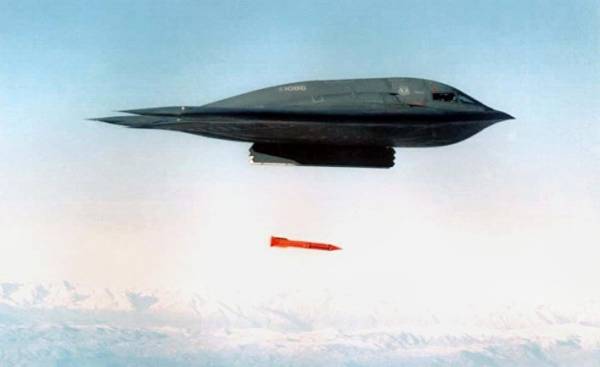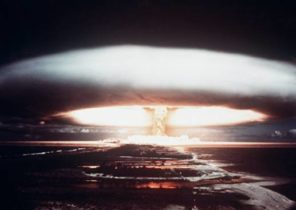
Military “the backbone” of the US are 450 Intercontinental ballistic missiles “Minuteman III”. An 18-metre giants with a speed of 30 exceeding the speed of sound, can hit the most populated areas of the Earth. One such missile can deliver to the target the charge, in 20-25 times greater than the bomb detonated over Hiroshima. Located at three bases in Montana, Wyoming and North Dakota — systems threatened with destruction every aggressor who dares to use nuclear weapons against the United States.
During the cold war this threat has provided the world, and today plays an important role for the armed forces of the United States. But ballistic missiles and their bases are in poor condition. “You say that you are the main in defense of the country, and so you shall… in a plastic bag” — one of the rocket scientists criticized in the American magazine Mother Jones of the old infrastructure, which was created in 60-ies. The repair of a toilet, according to reports, continues for three months.
Hygienic construction of the command post are unlikely to have strategic value, but they are an indication of the poor state in which all the nuclear forces of the United States. Age of Intercontinental land-based missiles is several decades, and a useful life greater portion of strategic bombers and Navy submarines, which are another important part of the deterrent force of the United States, is nearing the end.
After the end of the cold war, most of the huge defense budget of the United States was focused on conventional forces, which Washington used in different crisis areas. A nuclear deterrent force then was sidelined. While it’s not particularly bothered of the US military. “Containment is of special interest not age weapons, and does it, and whether it can be quickly implemented,” — said General John E. Khayten (John E. Hyten) 4 April the defence Committee of the Senate of the United States. Evaluation of future strategic commander special forces, were very pessimistic. “Therefore, modernization should be a priority,” said Khayten senators.
Modernization of nuclear forces need not only the United States. “In all nine nuclear powers are long-term modernization program,” says Shannon Keil (Shannon Kile), an employee of the Swedish Institute of problems of world SIPRI, working on the situation in the field of nuclear weapons. Three known nuclear powers — Russia, Britain and France planned to hold a General modernization of its armed forces, and the “new” nuclear States — from Pakistan to China — think about the escalating nuclear Arsenal. It’s not a particularly good time for supporters of disarmament. “None of the nine States in the foreseeable future, will not abandon its nuclear weapons,” said Shannon Keil.
The main focus is on the two rivals in the cold war, even after several rounds of disarmament the major players in the arena are the US and Russia. They have a total of approximately 7,000 nuclear warheads. It — more than 93% of all nuclear weapons on the planet. Both powers, after the peak of the cold war have significantly reduced their arsenals, but in the mid 80-ies they were still a total of 70 thousand warheads. Both powers could with such weapons several times to destroy every inhabited area of the earth’s surface.
Remain in force the disarmament treaties that set limits on the arsenals of Moscow and Washington. The US government still claimed that he didn’t want to develop new nuclear weapons. Will the government trump and in the future to follow the same line, it will become clear only after it finishes the evaluation process of their own deterrent force.
Earlier, the Nobel peace prize laureate Barack Obama (Barack Obama) has begun an ambitious program of modernization of all nuclear weapons. On the agenda, according to the budget Commission of the Congress, there is a question about $ 400 billion for this purpose up to 2026. Independent analysts believe that we are talking about billions of dollars needed to bring the nuclear deterrent into the desired state.
The program includes new Intercontinental and cruise missiles, modern strategic bombers and submarines, modernized warheads for strategic and tactical use and General modernization of the entire nuclear infrastructure. In Russia this program is carried out long enough and have achieved significant results.
For example, the group commissioned three modern strategic nuclear submarines in the North sea and in the Pacific. Scheduled to build five more.
Russia is blamed that it has deployed a new cruise land-based missiles in the European part of the country and thus has violated the agreement on reducing the Arsenal of missiles and medium-range missiles in Europe. The accusation was formally made on March 8 by the U.S. government, when the Deputy chief of the General staff, General Paul Selva (Selva Paul) made a detailed report to the defence Committee of the house of representatives. A denial from the Kremlin was not long in coming.
Critics of modernization programs fear a new arms race, because the modernization is not only the upgrading of the nuclear potential but also its significant increase.
“The US clearly leads to the fact that we expect the nuclear States that want to wage a nuclear war and win it by sudden shock”, wrote SIPRI researcher Hans Christensen (Hans Kristensen) with a member of the Massachusetts Institute of technology Theodore Postolos (Theodore Postol) and employee of the defense Council natural resources Matthew McKenzie (Matthew McKinzie) in the edition of the Bulletin of the Atomic Scientists. Exactly the same thing involves the Russian program.
Familiarity with the process of modernization of the B61 bombs shows that scientists understand this term. In 1968, was produced 3150 such bombs. There are 11 modifications of this shell, of which only one relates to strategic nuclear weapons. The bomb is from 0.3 to 400 kilotons. There is even a modification that allows you to destroy underground fortifications. At the airbase Fliegerhorst Büchel in IFile there are about 20 such bombs. In the event of war they may be dropped from a German Tornado.
Since 2008 are the preparations of the 12th modification of the bomb. Costs is estimated at one billion dollars. The Obama administration has officially named this work of modernization. It will be 366 by the modernization program, however, even in Congress wonder whether it really is about creating entirely new weapons.
The modernization of nuclear weapons is an everyday process because it is like any other weapon — is aging. This process to a lesser degree affects of a nuclear warhead, which upon explosion creates an incredible effect destruction. A group of advisers in the sphere of defense Jason (Jason Defense Advisory Group) — an Alliance of University scholars, whose purpose is to advise the Ministry of defense reported in 2007 that, according to its estimates, the service life of nuclear material is 100 years.
Other components of modern bombs need to be replaced more often. For example, to launch nuclear fuse uses conventional explosives are processed by special glue from artificial substance. The service life of the adhesive is limited. Neutron generators used to enhance the power of the explosion, also have limited lifespan. They use a radioactive isotope of hydrogen — tritium, the half-life of 12.32 years is. In addition, these devices use sophisticated electronics, which is necessary even for unguided bombs such as the B61 to determine the time of blasting and to prevent unplanned or unauthorized actuation. Necessary and upgrade of the onboard systems for the B61 bombs.
Brand new is the guidance system, which must be equipped with the bomb. It turns it from “blind” ammunition, which hardly can be managed with the help of gravity when pointing at the target, precision guided bomb. The accuracy of modern bombs model B61 — 130-180 meters, which kompensiruet greater force of the explosion. New guided bombs, according to the Federation of American scientists, aiming more precisely using a combination of data on-Board compass and GPS. Accuracy within five meters. If GPS fails or if there is interference, the average is 30 meters. Thus, the new atomic bomb can achieve your goal with a less powerful warhead.
Her supporters think this is a new big advantage: the blast effect and radiation are concentrated on military targets, and adverse impact on the environment is reduced. Critics see this ability to apply a “surgical strike” a dangerous opportunity of increasing the us nuclear potential.
The threshold threat of use may be reduced so that the unthinkable becomes possible. “I fear that we are developing technology that will lead to the fact that the weapons will really be used, because it’s not that bad,” he said in may, former Ambassador to NATO the Obama administration Daalder Ivo (Ivo Daalder) during the discussion of the Chicago Council on global Affairs (Chicago Council on Global Affairs).







